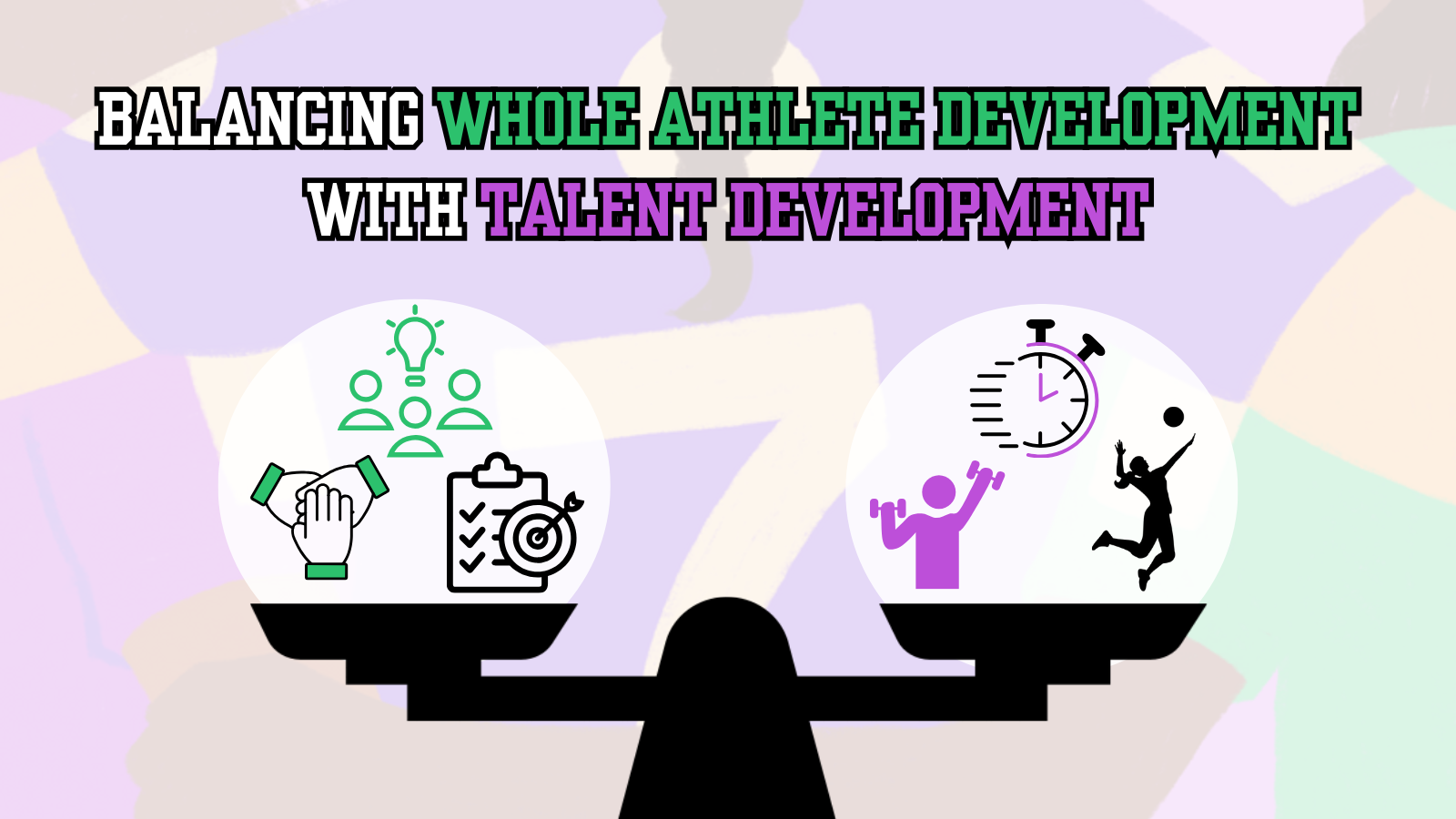
By Dr. Jennifer Roth
Michigan State University, Institute for the Study of Youth Sports
The youth sport environment can be a great place for youth to learn important life skills that they can transfer to other areas of their lives. However, this doesn’t happen automatically for kids who participate in youth sports, rather the coach needs to be intentional in creating an environment that fosters life skill development. One of the challenges for coaches is balancing talent development while also focusing on whole athlete development. By using specific strategies, this challenge can be overcome, and coaches can include both goals for their athletes.
Recently, in the United States, there has been an increase in the professionalization of youth sport. Youth sport is moving away from community-based, recreational programs to a model that replicates professional and college level sports. Parents have become more involved as well with high expectations and big goals for this child’s sport career. There are even national rankings for 8-year-olds in several sports.
With the professionalization of youth sports, whole athlete development becomes a second priority to short-term outcomes like winning. This can lead to early specialization which is associated with many concerns such as over-use injuries,1 burnout, and eventual drop-out of the sport.2 The emphasis on winning and early success makes it increasingly difficult for coaches to focus on life skill development and talent development.
There are a few differences in the talent development approach as compared to the approach taken to develop the whole athlete. When working to develop talent, coaches are looking to help athletes fulfil their protentional in a specific domain or sport. This may mean creating a high-performance environment that is highly competitive. While in the whole athlete development approach, coaches focus on developing life skills and using sport to develop better people.3 4
There are also many features of effective talent development environments that overlap well with the whole athlete development approach. These include creating a challenging and supportive environment, integrating sport with other areas of life (i.e. school), and the use of a strong support network.5 Additionally, there may be some skills that can be used for performance enhancement that we would also categorize as life skills such as resiliency.
The tension between the two approaches arises when the psychological care of the athletes becomes an afterthought when talent development becomes a priority. High–performance environments associated with talent development may not be psychologically safe or can be an afterthought. This type of environment does not often foster cooperation, can lead to limited relationships and interactions with non-sport peers, and the type of support and involvement from parents varies.6 This is also true for the coach’s environment. The emphasis on games over practices, rankings and standings, and the importance of playoffs and championships, along with the high cost of participation do not provide much opportunity for coaches to focus on whole athlete development.7
However, there are opportunities for coaches to focus on whole athlete development within a talent-development setting. These include both direct and indirect strategies of developing meaningful relationships, providing leadership opportunities, integrating teachable moments into session plans, and promoting positive social norms.
Develop Meaningful Relationships
Strong and trusting relationships are one of the most important components of a whole athlete development approach. As the saying goes “Athletes don’t care what you say until they know you care.” Ask your athletes questions about themselves outside of sport, listen to what athletes say and show you’re interested, give plenty of positive reinforcement, and be consistent and clear in your communication with them.
Provide Leadership Opportunities
Provide all athletes on your team opportunities to take on a leadership role. This empowers the athletes, provides them with autonomy, and gives them the opportunity to practice important leadership skills like communication, problem-solving, and decision-making. At the same time, make sure to provide leadership training to the athletes. This can be done through modeling behaviors and having discussion about the skills needed to be an effective leader.
Integrate Teachable Moments into Practice Plans
When developing practice plans, be deliberate about setting aside a short amount of time to dedicate to life skill development. For example, teach your athletes how to set goals or how to manage their time. Then use informal time that you have together with the athletes, on bus rides or at team dinners, to discuss how they are transferring the skills they are learning in sport to other aspects of their lives.
Promote Positive Social Norms
As the coach, ensure that you include expectations for the athletes related to positive social norms, like respect, sportsmanship, and a love of learning. This is important as the competitiveness of sport often normalizes harmful or antisocial behaviors (such as taunting or intimidation).8 Modeling and expecting prosocial behaviors such as helping an injured opponent or providing positive feedback to a teammate can contribute to an athlete’s overall development.
It is possible for you to integrate both a talent development approach and a focus on whole athlete development. Research suggests that these do not need to be mutually exclusive.9 While there may be tension between the two, there are certain strategies (listed above) that can assist you with your goal to contribute to the athlete’s development in and out of sport. Overall, it is important to be intentional in your efforts and plan effectively for life skill development.

About the Author
Dr. Jennifer Roth is an Associate Professor in the Department of Kinesiology. She teaches courses in the Sport Coaching, Leadership, and Administration online graduate programs. Her research interests include coach education, online teaching and learning, positive youth development through sport, and modified youth sports. She has consulted with the United States Tennis Association and has worked as a sport psychology consultant for numerous teams and athletes.
Note: This material was produced as part of a collaboration with Coaches’ Tool Chest (CTC), an organization that conducts training for sport coaches.
- Jayanthi, N. A., LaBella, C. R., Fischer, D., Pasulka, J., & Dugas, L. R. (2015). Sports-specialized intensive training and the risk of injury in young athletes: a clinical case-control study. The American journal of sports medicine, 43(4), 794-801. ↩︎
- Wall, M., & Côté, J. (2007). Developmental activities that lead to dropout and investment in sport. Physical education and sport pedagogy, 12(1), 77-87. ↩︎
- Fraser-Thomas, J. L., Côté, J., & Deakin, J. (2005). Youth sport programs: An avenue to foster positive youth development. Physical education & sport pedagogy, 10(1), 19-40. ↩︎
- Harwood, C., Spray, C. M., & Keegan, R. (2008). Achievement goal theories in sport. ↩︎
- Martindale, R. J., Collins, D., Wang, J. C., McNeill, M., Lee, K. S., Sproule, J., & Westbury, T. (2010). Development of the talent development environment questionnaire for sport. Journal of sports sciences, 28(11), 1209–1221. https://doi.org/10.1080/02640414.2010.495993 ↩︎
- Holt, N. L. (2016). Positive Youth Development Through Sport : Second Edition (Vol. Second edition). Abingdon, Oxon: Routledge. ↩︎
- Preston, C., Allan, V., & Fraser-Thomas, J. (2021). Facilitating positive youth development in elite youth hockey: Exploring coaches’ capabilities, opportunities, and motivations. Journal of Applied Sport Psychology, 33(3), 302-320. ↩︎
- Kavussanu, M., & Boardley, I. D. (2009). The prosocial and antisocial behavior in sport scale. Journal of sport and exercise psychology, 31(1), 97-117. ↩︎
- Preston, C., Kerr, G., & Stirling, A. (2015). Elite athletes’ experiences of athlete centered coaching. Journal of Athlete Centered Coaching, 2(1), 1–27. ↩︎




